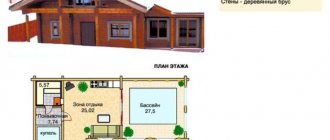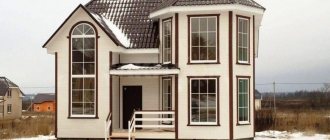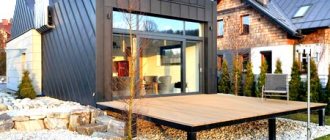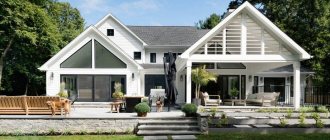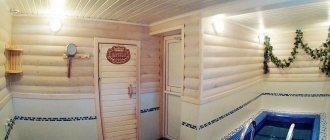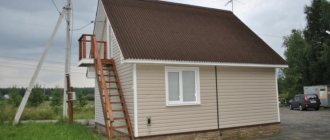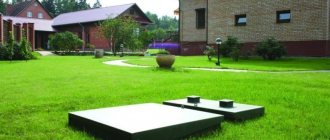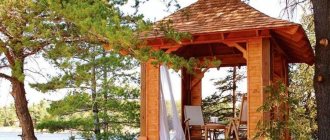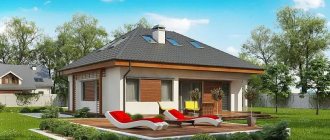When choosing to build a private Finnish-type cottage, many customers prefer house designs with a sauna inside rather than in a separate building. This provides significant cost savings not only on building materials, but also on laying utility networks. The advantage is also ease of use, and a bonus in the form of an additional source of heat in winter.
Not everyone is a fan of the dry heat that a sauna provides. The built-in Russian bathhouse is no less in demand, and projects with a Turkish hammam are becoming increasingly popular. From the point of view of the bath ceremony, they are all different, but for construction this difference has no practical significance. In all cases, precautions must be taken, since the risk of fire increases and the humidity in the premises of the house increases.
How to choose a stove?
The basic requirements for heater stoves installed in home saunas are:
- There should be no cold water tank on the stove - this will help to avoid rising humidity levels.
- The oven should not be too small - otherwise it will not be able to provide the necessary dry air.
- Only high-quality natural stones should be used in the oven - this could be, for example, jadeite, vulcanite, gabbro-diabase.
If it is not possible to install a traditional stove for some reason, it is possible to install an electric stove with a built-in heating element. This modern option for heating a sauna will save money and allow you to easily regulate the air temperature level.
Free selection of equipment for saunas and baths:
Typical mistakes during construction
To avoid problems with the performance of the bathhouse, it is worth considering the most common errors:
- Carefully calculate the size of the premises based on the number of people.
- Correct ceiling height. You should not make ceilings lower than 2 meters, since it is not comfortable to be in such a room. In a room with ceilings higher than 2.4 m, there is an overconsumption of coolants.
- The southern and western walls are allocated for windows, and the southern one for the door.
- The windows are not too large - this will help avoid excessive heat loss.
- Use energy-saving materials.
- Choose quality equipment.
Advantages and disadvantages
In addition to saving space, the bath house has other advantages:
- Creates everyday comfort. To wash and return from the bathhouse, you do not need to leave the house, outside of which it may be cold and damp. This is doubly true for people who often suffer from colds, whose condition is affected by temperature changes in the most unpleasant way, and also when it comes to washing children. Taking them from the bathhouse to the house in the cold is not the most useful activity.
- Building a bathhouse under the same roof as a house is financially beneficial. In this case, there is no need to create a separate rest room for the bath building, since the house already has one. It is no coincidence that such projects often provide for the arrangement in a single complex of only a dressing room and a steam room as elements of the washing area.
- The solution to the issue of creating utility networks is simplified, as well as the material costs for this.
- The construction of a single complex is proceeding faster.
- The costs of maintaining two different buildings are reduced, especially taking into account the fact that large temperature changes cause a separate bathhouse building to quickly become unusable. And when it is located in a single complex with housing, the overall microclimate is quite stable.
- For the same reason, it is always possible to prepare a bathhouse for work faster if it is combined with a house.
- Some sauna rooms inside the house can be conveniently used for drying things, including washed clothes, which is important for any housewife.
The other side of the bathhouse also promises certain problems:
Fire safety issues in such a building have to be given increased attention. What matters here is the material chosen for construction, the location of the building, and so on.
If the bathhouse is built of wood, fire safety requirements will be especially stringent.
- Since houses combined with bathhouses are considered objects of increased fire danger, their insurance is more expensive than ordinary houses.
- If the construction technology is violated, the bath house will suffer from high humidity, which, in turn, can lead to the appearance of fungus and the spread of mold with all the ensuing consequences.
- Large bathhouses require careful design of the heating system. Here you will need a powerful electric or gas boiler so that you can heat both parts of the building without any problems. You will have to pay a lot for the use of consumed resources.
What to build a sauna from
There are two options for arranging a sauna - in a separate building or inside the house. A self-contained sauna saves space in the house and, in the event of a fire, prevents the fire from spreading to the main building. But it requires a separate connection of communications, as well as more building material.
A sauna inside the house with an internal entrance will be cheaper; you won’t have to walk down the street to get there in any weather. But there are a number of inconveniences - any malfunction in the steam room will create discomfort in the house.
There are compromise options - a separate sauna connected to the house by a warm passage or a sauna in the house, but with a separate entrance from the street. The decision about which option to choose rests with the host or hostess alone.
The set of premises included in the bath complex depends on the chosen location and preferences of the owners of the house.
Foundation and floor
For a free-standing bathhouse, a strip concrete foundation is most often used. If your area has high groundwater, then you need to take care of drainage. Otherwise, the foundation will become damp, and moisture will spread from it to the walls and floor finishing.
This is what a strip concrete foundation for a sauna looks likeSource sdelai-lestnicu.ru
The difference between a concrete foundation is strength and durability without additional reinforcement. Concrete is not washed away by water, does not become damp, does not rot, and can withstand heavy loads. The main disadvantage of a concrete base is cold. Be sure to put additional insulation on the floor, otherwise walking on it will be unpleasant.
You can put logs or insulation on top of the foundation. The floor on the joists and posts creates an air cushion that acts as a natural insulation. With an earthen floor and good moisture treatment, the floor will be well insulated from cold air from the street. But if the design is made incorrectly, the floor will be cold and will collapse over time.
It is better to lay artificial insulation on top of a concrete base. It can be combined with a log floor and placed between two layers of boards, or used independently. Foam plastic, cork, and mineral wool are used for the floor. All these materials do not burn or rot.
The floor must be thoroughly insulatedSource bouw.ru
Walls, doors and windows
An ideal option for those who are thinking about how to make a sauna with their own hands inexpensively is a wooden frame. Wood costs little, is harmless to human health and the environment, and is easy to work with. If you avoid any cracks, the wood retains heat well, and with good care it lasts a long time.
For a log house, it is better to choose logs rather than boards - they retain heat better, and this is the main function of a bathhouse and sauna. There will be no high humidity in the sauna, so you only need to protect the log house from water from the outside, using water-repellent impregnations. Mineral wool is better suited as insulation between the log house and the finishing of the walls - it takes up little space, retains heat in the building, but not moisture
In addition, mineral wool does not burn, which is important in a wooden frame
The wooden structure looks very cozy Source pinimg.com
Another option for walls is brick. This is more expensive and takes longer than building a log house, but it is safer in terms of fire. On the plus side, such walls will last a long time without additional maintenance; they do not need protection from water. Disadvantages - thermal inertia of brick. It is better to have constant heating in such a sauna, otherwise in winter it will take a long time to warm up.
Doors and windows in the sauna:
- The outer door can be wooden or iron, depending on the convenience of the owner. To prevent heat from escaping through it, additional upholstery is needed. It should close without obvious gaps and not create drafts.
- Interior doors - chipboard, fiberboard or other wood-based materials. You don't have to insulate them, they should close tightly.
- The steam room door is made of boards or tempered glass, strictly without metal parts, especially on the inside. It should close as tightly as possible so as not to release heat, but open without effort. It is better if it opens outwards. It is strictly forbidden to install a lock.
There should be windows or vents in every room, including internal ones. They are closed before you begin to wash and steam, and open after the procedures are completed. This is necessary to quickly ventilate the sauna and eliminate excess heat and humidity.
An influx of fresh air is requiredSource yandex.net
Sauna in the basement or on the ground floor
The sauna can be placed in the interior of the house - then it will be in a warm zone, and less costs will be required for thermal insulation. The walls can be made of the same material as the walls of the house; they do not need to be insulated. The floor is insulated only when the sauna is located directly on the foundation or above a cold basement.
Projects of residential buildings with a bathhouse under one roof
You can come across many projects where the bathhouse is in the house, and not on the territory. This solution is popular because of its ease of use and space saving in small areas. In order to save space, you can design a house with a bathhouse and a garage.
Advantages of bathhouse projects with a house under one roof
- It’s easier to work with communications, because they are located within the same building (the costs of their installation are reduced);
- heating the internal steam room takes less resources and time, it retains heat for a long time;
- the transition from home to the bathhouse and back is not accompanied by a sharp change in temperature;
- a separate foundation is not required, and construction is faster.
What are the disadvantages associated with construction?
- it is more difficult to comply with construction rules in accordance with SNiP (for example, enhanced hydro- and thermal insulation is required, compliance with fire standards);
- communications require professional calculation, because the load increases;
- insurance is more expensive because the building has an increased risk of fire;
- If construction standards are not followed, you may encounter improper functioning of the steam room and washing room (mold due to excess moisture, insufficient heating, etc.).
Tips for use
Taking a steam bath and warming up in a sauna are completely different procedures. The fact is that a Russian bathhouse produces wet hot steam, while a Finnish bathhouse produces dry steam. Therefore, time in the sauna is spent differently.
Optimal temperature
According to the rules, the air temperature in the sauna should be from 85 to 90 degrees. In order for such an atmosphere of a Finnish bath to bring benefit and not harm, when entering the room, you do not need to immediately sit on the upper bench. You need to give your body time to get used to the hot environment by sitting on a bench that is close to the floor. In order for the high temperature to have a positive effect on your health, it is recommended to rest in the sauna for 15 minutes.
To control the temperature in the sauna, install a thermometer
Visiting rules
In order for the heat of the sauna to have a beneficial effect on the body, you need to do the following:
- before entering the steam room, rinse off in the shower and dry your body well with a towel;
- sit in the sauna in a special hat made of felt or felt, because the head must be protected from exposure to high temperatures;
- bask in the steam room in several sessions, that is, several times to give the body the opportunity to rest from the heat for about 10 minutes;
- Before entering the steam room again, it is recommended to drink cool water;
- take a steam bath in a lying position, which allows you to completely relax your muscles and makes your heart rate calmer;
- After leaving the steam room, you should take a shower.
Options
If a bathhouse is a way of life or a commercial investment, then you can consider options with additional options that will enhance your pastime and relaxation. Combination options are also popular.
With terrace
If the rest room is an enclosed space, then it will be nice to go out onto the terrace to get some fresh air. In the summer, you can even move the recreation area outside, equipping it with comfortable chairs, a table, a hammock or sofas with armchairs. In winter you can go out to the terrace to cool off.
The size can also be customized. If the terrace is planned as an outdoor recreation area, then it can be made the entire width of the bathhouse, as well as with a turn. A spacious square open veranda on the same foundation as the bathhouse and under the same roof can be used as a gazebo at any time.
There is a possibility of installing a swimming pool on the large terrace
The canopy will not allow the water to heat up too much from the sun's rays, which is so important when you want to freshen up, and leaves and fluff will not fly into the pool in large quantities
With swimming pool
If you don’t want to install a pool on the terrace, you can do it inside the bathhouse. A separate room can be allocated for the pool, which can be accessed directly from the steam room, but more often there are projects in which the pool is located directly in the relaxation room.
A small 2x2 version with cold water can serve as a river ice hole. Heating will be needed for swimming pools. For a comfortable stay, a size of approximately 6x3 is suitable. For entertainment, you can install waterfalls, water cannons or a hydromassage system in such a bathing pond.
Contrasting dips can be achieved without complex pool installation. Small fonts that resemble a huge barrel are available in stores that sell bathhouse equipment. They do not require digging a pit, complex finishing or a filter system. For a comfortable dive, a ladder leads to the font.
With veranda
By combining a terrace and a recreation room, it is possible to save space on the site. The veranda can be glazed with sliding windows, which will close in the cold season and swing open in the summer.
This option is worth considering for those who are planning to build an object for summer use in the country. In addition, sliding windows can be equipped with mosquito nets, and in the summer this is the best salvation from mosquitoes, moths and flies.
With bathroom
For a comfortable stay in the bathhouse for several hours, it is worth thinking about arranging a toilet, especially for commercial projects. You will have to incur additional costs for arranging communications, but a bathroom inside the bathhouse is simply necessary, especially in the cold season.
With attic
There are a lot of designs for bathhouses with an attic floor. It can be used as a guest room - equipped with a bed, or you can install a billiard or tennis table, a plasma TV, armchairs or a sofa.
Small projects involve a layout where the first floor is occupied by a steam room, a washroom, and a terrace, and the second floor is a relaxation room.
Interesting options for bathhouses with an attic, which include a balcony. This way you can enjoy the view from above and arrange an additional seating area with chairs and a table on your balcony.
When deciding to build a bathhouse with an attic floor, it is better to choose projects in which the roof is gable and sloping. This increases the usable space. In addition, you should consider a thermal insulation system between levels
This is important for maintaining a better microclimate in the steam room
Two-story
If a one-story building is just a bathhouse for the sake of a bathhouse, then an object with a second floor can proudly bear the title of bathhouse-house. Increasingly, just such buildings are growing on private dacha and suburban plots. The cost of constructing such a facility is less than the construction of two separate buildings. United by one roof and standing on the same foundation, the bathhouse and the house have their own characteristics.
The first floor is usually occupied by a steam room, a washroom or shower, a kitchen with a rest room, a bathroom, and a vestibule. On the second floor there is a hall and two bedrooms. The size of such a building with the optimal number of rooms is 6x6 m. The layout may provide for additional premises: a terrace, a firebox, a dressing room, a utility block, a firewood shed, and a balcony.
The purpose of building a bathhouse as a determining factor of cost
Calculating the budget that you can spend on building a bathhouse follows from the considerations that the foundation, frame and roof must be erected almost immediately, in the shortest possible time.
Let's consider the most popular motives for buying a bathhouse:
- For a joint holiday with friends. An excellent option would be a separate bathhouse, with a large steam room and an oversized swimming pool. It is better to make a warm rest room separate from the locker room and design the entrance in such a way that after dousing yourself in cold water, you can immediately warm up in the warmth.
- For a family holiday of several people with a child. The option of a home Russian bathhouse in the basement is the most acceptable, since any woman can fire a small-sized brick stove. For a dry sauna, it is recommended to purchase an electric stove that operates from a common network. It is easily controlled using a relay and has temperature sensors with automatic locking.
A detached bathhouse with a veranda - comfort and independence, where you can spread out in a big way. Source krov-torg.ru
Bathhouse for rent. Definitely, for such purposes, only a free-standing bathhouse is needed if it is rented without a cottage. In order to increase future income, reduce the area of the rest room and make two steam rooms: with wet and dry air. In addition, visitors will appreciate it if you provide several sources for bathing and dousing with cold water.
As they say, what is good for a Russian is death for a German. This is probably why a Russian bath strengthens a person’s character and stamina, developing a steel core in him.
Types of saunas and layout
Before selecting a project for a house with a comfortable sauna, you should first decide on the location of the steam room and look at photos of interesting models. To design a steam room, any room that provides high-quality ventilation and the presence of all types of communications is suitable.
If you have already decided on the area, you should decide how many people can accommodate there. For a married couple, a miniature-sized cabin will be enough, but to receive guests, you will have to provide, in addition to the steam room, an additional room for relaxation.
Built-in sauna
This type of steam room requires little space in the house. It is convenient because there is no need to go anywhere, since it is located on the first floor of the building. The built-in bathhouse project is compact and its price is inexpensive. The heating system is based on heaters, electric or gas furnace. A prerequisite for a built-in model is good thermal insulation and ventilation. In other characteristics, the owner is given freedom of choice.
Prefabricated sauna
A very convenient solution for arranging the first floor of a building. According to the design, the structure is mobile and easy to assemble. This is an excellent quality for those who prefer to change the layout of their home frequently. This type of design could be:
- Shield - involves the assembly of panels for walls and ceilings.
- Bruskov - involves assembly from special beams, so the bathhouse turns out to be environmentally friendly. Assembly from wood materials is inexpensive, and the price can save your budget.
The prefabricated type of sauna according to the project, photos of which are presented on the Internet, reflects the simplicity and beauty of the Russian steam room. This type of sauna is suitable for houses with a small area, where every square meter is valued.
Infrared sauna
Infrared sauna designs are suitable for decorating houses, regardless of floor, and for apartments. This small cabin is designed for several people, and its price is suitable for people with average earnings. There is no high temperature in this home steam room, and the body is heated by infrared radiation. Thus, the skin heats up by 5 cm, and not by 1 cm, as in a regular sauna.
The design of a house with an infrared sauna involves placing it on any floor, since it does not take up much space and does not require special technical conditions.
This model has no effect on breathing or vision because it does not contain steam. In addition, the absence of pressure surges has a beneficial effect on the body. In one session you can actually lose up to a kilogram of weight. If the procedures are carried out regularly, women can get rid of cellulite and tighten their skin.
The project of a house with an infrared sauna can be viewed on the Internet, where with the help of photos you can clearly see the comfort and beauty of the interior. There are single and multi-person options available. In the first case, the steam room can be placed on the floor in a spacious bathroom or on a glazed loggia.
Infrared saunas, which are affordable, can be either portable or built-in. They do not require specialized care or forced ventilation.
Advantages of a house combined with a bathhouse
The main advantage of such a house is your comfort. You don’t need to run out anywhere in bad weather or winter cold, especially if there are children in the family. Having steamed and bathed, you simply go to the kitchen or bedroom in your slippers. Based on the preventative effect of a bath during the cold season, it is very convenient to always have your own steam room nearby.
When combining a bathhouse with a house, you will get rid of the costs of maintaining a separate bathhouse.
The speed of construction of such a house at minimal cost.
A residential bathhouse with a second floor is one of the attractive projects in conditions of limited square meters of land. A sauna with a relaxation room and a bathroom are located on the first floor, living rooms are on the second.
Bathhouse with attic and covered terraceSource gid-str.ruHow to decide on the size
Before plunging into the exciting search for a suitable bathhouse, it is useful to decide on the area of the future purchase; This will help you immediately weed out options that are unsuitable in size and save a lot of time. The desired minimum dimensions of a bathhouse are determined by the dimensions of three rooms: locker room, washing room and steam room, taking into account the following factors:
- According to SNiP standards, one visitor should have from 3 to 4 m2 of usable space (minus the area occupied by the stove and other devices).
- The average number of visitors who will use the bathhouse at the same time is estimated.
- Tambour. An extremely necessary room that reduces heat loss and protects from drafts.
The vestibule is a room that should not be abandoned Source remont.jollow.me
If three people simultaneously enjoy bath procedures, then the minimum allowable area will be 12 m2, of which 1 m2 will be required for the vestibule, 5 m2 for the dressing room and shower room, and 5 m2 for the steam room. – 6 m2.
If you like the traditional layout of two rooms (when the locker room is combined with a relaxation room, and the steam room with a washing room), pay attention to baths 3x4 or 3x5 m. If you want to have a separate washing room (install a shower), the option with dimensions will be more comfortable 4x4 or 4x6 m
And now, about the shortcomings
- The main disadvantage of a house with a bathhouse is the need to comply with fire safety requirements. There are several of them and they differ depending on the situation. This includes taking into account: the material from which the building is constructed, the location of the bathhouse and other factors. Particularly stringent requirements for wooden houses with a bathhouse.
- If you ignore them, then at the stage of paperwork, there is a risk of not getting approval from official services for the so-called commissioning (fire, sanitary, electrical and other services). This means that the operation of such a house will be considered illegal. And don’t try to make a bath inside the house, secretly. If they find out about this, you can pay with considerable fines and shutdown of utility networks (electricity, gas);
Perhaps I have listed the main “horror stories”.
About placing a bathhouse in the house itself. Two main options:
- In the basement or basement. If, of course, they exist;
- In a single complex next to the bathrooms (bathtub and toilet).
Design of a relaxation room in a bathhouse
A compact sauna measuring 3x3 m can be used by no more than 4 people at the same time. This building accommodates a recreation room with an area of 3x1.5 m. The average bathhouse in a country house is designed for 4-6 people.
When designing, the size of the locker room, washing room and steam room may vary, since these rooms are rarely used by the entire company at the same time. Sometimes a washing room and a steam room are combined to increase the usable space. All guests should be able to comfortably sit in the relaxation room, so they try to make it as spacious and cozy as possible.
Interior materials
There are special requirements for the interior decoration of the bathhouse, which, of course, is due to the peculiarities of the operation of the building (the air temperature in the steam room of a classic Russian bathhouse reaches 60-70°C, and humidity - 70-80%). The atmosphere in the relaxation room is not so extreme, so the choice of materials for its decoration is wider.
Natural materials are the key to quality relaxation Source pinterest.com
Decorating a relaxation room in a bathhouse implies a natural and environmentally friendly environment. Wood is considered the best material, and if coniferous wood is not used in the steam room (the released resin can cause a burn), then any material is allowed here. Lining made from linden, alder, aspen, as well as pine and Lebanese cedar wood is widely used. For the floor, larch is a practical choice. Oak is a great solution, but it can’t be called budget-friendly. To emphasize the exclusivity of the decor, exotic and expensive wood from African trees is used in the design: abacha (another name for abash), afar (ofram) or merbau (meranti).
To ensure that wood does not lose its original appearance in conditions of high humidity, periodic maintenance is required. Wooden surfaces are treated with a water-based antiseptic; this will help preserve their natural color and protect against damage.
The rest room can be elegantSource strmnt.com
Registration requirements
If the bathhouse is made of logs or timber, then the main task of decorating the rest room is considered completed. Walls made of natural wood are beautiful in themselves and, as a rule, do not require additional finishing. The matter remains with choosing comfortable furniture, installing equipment and selecting suitable utensils and accessories.
If the bathhouse is built of brick, blocks or frame material, the walls need insulation and waterproofing. Then they are optionally covered with clapboard or plastered. A fairly popular option is to decorate walls with natural or artificial stone or ceramic tiles. When thinking about the design of a relaxation room in a bathhouse (at the dacha), they care not only about beauty, but also about convenience. An attentive owner will definitely provide:
- High-quality ventilation and soft lighting.
- A convenient mirror and an electrical outlet nearby.
- Lockers or dedicated space for personal belongings and bath accessories.
- Cabinet or shelves for dishes.
- Fans of spa treatments will be pleased with the sun lounger (which can be successfully replaced by a regular couch).
Modern and cozySource pinterest.dk
Favorite options for decorating a relaxation room in a bathhouse are the following styles:
- Russian style. An obvious and least expensive solution that perfectly conveys the atmosphere of relaxation. The laconic appearance of wooden walls (both made of natural wood and lined with clapboard) is perfectly complemented by deliberately simple or carved furniture, brooms, textiles and a samovar hung on the walls. The stove will become the highlight of the interior.
- Chalet style. Fans of European history can decorate the ceiling with beams painted in a contrasting color and delight guests with a fireplace.
- East style. You can limit yourself to comfortable sofas, a pile of pillows and a hookah on a low table. Or you can go further and decorate the room with mosaics - expensive, but impressive and atmospheric.
Budget option - fast, cheap and eclecticSource inmyroom.ru
- Sea style. Wooden walls are perfect for nautical-themed designs. Even a small rest room can be turned into a ship's cabin, you just need to choose the appropriate design - white, sand and blue shades of color, themed accessories and simple-shaped furniture. A model of a sailboat, a tropical shell and a barometer on the wall would look great here.
- Eclecticism. The combination of styles is a growing trend in recent years. A hookah or an elegant tea set in the room “a la rus” - why not.
Style
Depending on the taste, preferences and needs of the owners and finances, the style of the bathhouse can be very diverse - Russian bathhouse, chalet, Finnish sauna, Turkish hammam, Roman bathhouse, Japanese bathhouse (ofuro, sento or furako), etc. Each type of bathhouse has its own a certain style of construction and interior. In addition, it can be built in a common style with the house and other buildings on the territory. Let's consider several styles of bathhouse interiors.
A Russian-style bathhouse, as a rule, implies the presence of only two or three rooms: a dressing room, a wash room and the steam room itself. “Lubok decor”, wooden carvings, brooms on the walls, an embroidered tablecloth and a samovar, as well as rugs on the benches are considered traditional. The Russian bathhouse is small in size, making it easy to warm up to the desired temperature. The average room temperature is from 45 to 70 degrees. Construction materials are usually wood, less often brick. A mandatory element of a Russian bath is a brick or metal stove. It is usually located between the relaxation room and the steam room. Ideally, a Russian bathhouse is built near a pond. If it is not there, a font or pool is installed next to the bathhouse building.
A Scandinavian-style bathhouse (Finnish sauna) differs from a Russian one, primarily in that the air temperature in it significantly exceeds the temperature of a Russian bathhouse and reaches 130-160 degrees. The Finnish bathhouse has a very simple interior, a maximum of natural materials in decoration, a minimum of decor. Ideally, it should be located in a picturesque place so that after bathing procedures you can enjoy a beautiful view of the forest or lake. The interior decoration of a Finnish sauna is usually made of light wood. The furniture also has simple, clear shapes, without patterns or carvings. Scandinavian style is an eco-style, so emphasized environmental friendliness is visible in everything - from construction to decor. The interior itself may have 1-2 bright accents, otherwise neutral tones.
The bathhouse is in the style of a chalet - an alpine house, and also has some elements of country style, as well as eco. For the interior, natural wood and stone are used, natural skins, rugs and carpets in the relaxation room, original lighting using LEDs, mosaics, etc., as well as a mountain landscape from the window. There is a lot of wood in the decor (logs, logs, stumps, etc.). An oriental-style bathhouse (Turkish hammam) is characterized by the use of mosaics and tiles with oriental patterns. The decor has a lot of bright colors, red and gold. Figurines, ottomans, hookahs, chests of drawers, low tables and other furniture occupy almost the entire space of the relaxation room.
Materials
The basis of the bathhouse is the walls; they determine the reliability of the building, the quality of thermal insulation and, to a large extent, the comfort inside.
Most often, bathhouse walls are built from:
- bricks;
- foam concrete, aerated concrete;
- wood concrete;
- tree.
Brick walls are very difficult to lay. They have high thermal conductivity, so increased thermal insulation will be required. A foundation must be laid under brick walls.
Wood concrete is a mixture of cement with organic fillers, mainly crushed wood. Its properties are similar to foam concrete; it is also produced in the form of blocks. You can make it yourself right on the construction site; the technology is very simple. There is only one main drawback - low resistance to moisture.
Foam concrete and aerated concrete blocks have much higher thermal insulation qualities, moreover, they are much lighter and do not require a massive foundation underneath.
The size of a standard wall foam block is 20x30x60 cm, and it alone is equal to 13 sand-lime bricks. It’s not difficult to build walls from foam blocks yourself.
Wood is most often used to build baths in our country. There are enough wood species suitable for this; experienced builders prefer larch, pine, and cedar.
To raise the log house of a bathhouse, the following materials are suitable:
- logs (solid or rounded);
- sawn timber with a rectangular cross-section;
- profiled timber;
- glued profiled timber.
You can use either wet or dried material. The first one is better suited for a log house. The more moisture in the material, the more the log house will shrink. Glued laminated timber practically does not require shrinkage. A log house takes longer and shrinks more than others. There is no need to mention that wood is the most environmentally friendly material, so it is best suited for the construction of a bathhouse.
Steam room arrangement
The steam room is, of course, the most important of the rooms, and in Russian, the steam room is generally the main one. Most often it consists of burnt red brick, but you can use other materials, even ceramics. Increased temperature conditions and humidity in the room dictate specific rules in order to accurately select the material.
We decorate and arrange
For the steam room, only deciduous wood is suitable that can retain its qualities for many years (alder, linden, aspen). Floors are made both wooden and using tiles. If possible, preference should be given to tiles, since a wooden floor will slowly deteriorate.
We use tiles on the floor
Steam room with a window inside
There are natural boulders on the slab that accumulate and retain heat. Water pouring onto hot stones provokes the formation of wet steam, without which the whole essence of the steam room will be lost. The area of the room and its height should be small in order to achieve heating quickly and evenly. A water container should be installed next to the stove.
Another attribute of the steam room are shelves. Install them in corners or near walls. If possible, shelves are placed in several tiers. It is generally accepted that it is easiest to withstand the hot steam at the bottom, and not everyone can stay on the upper tier. In the end, it is under the ceiling that the bulk of the hot air accumulates, and it is very difficult to breathe there, but this is the main benefit of the procedure.
Shelves are an attribute of every bath
If the dimensions are small, then you can make the shelves narrow and rounded. Strict sharp corners will take up useful space. The best material for preparing shelves for a bathtub is linden and larch, which is quite justified from the point of view of a practical approach - the boards of these types of wood are resistant to moisture and rot, so products made from them can be used for more than a dozen years.
The best material for shelves is linden
The most affordable type of wood is pine, which, alas, is not at all suitable for arranging shelving; it cannot be used in a steam room, since when heated it releases resin that can ignite and cause burns.
Pros and cons of a bathhouse in the house
Of course, a good bathhouse is a luxury that you want to have with you. Therefore, many are considering options for country houses with a built-in bathhouse.
The advantages of having a bathhouse in the house can be divided into the following points:
- Availability. Despite the fact that a free-standing bathhouse is usually located on a site not so far from the house, a built-in one still has an advantage: it is more comfortable to heat and prepare for use. You won’t have to run around and check the firebox many times, control the temperature – everything will be at your fingertips.
- Minimizing colds. If there are children in the family, then you can’t think of a more ideal option with a bathhouse in the house. Hardening in the fresh air, swimming in the snow, constant drafts - this is suitable for avid bath attendants with extensive life experience than for women with children.
- Economical. It will take much more money to build a free-standing sauna than to build a small indoor sauna. What does it cost to install communications and supply hot water? Approximate budget savings can reach 50% if the layout of the basement floor is drawn up correctly and does not have “blind” places.
- Comfort of use. Usually, mini-saunas with more efficient heating and for short-term use are installed in the house. Such a sauna is easy to heat, however, the resulting heat does not last more than 6-8 hours.
Small saunas in the house are a compromise in the absence of funds and sufficient territory to build a separate full-fledged room. Source el.decorexpro.com
The following list includes the significant disadvantages:
Presence of dampness. As a rule, dampness appears when the ventilation system is not properly designed. In addition to the forced ventilation shaft, natural passages must be built into the wall openings, allowing warm air to freely leave the room.
- Presence of noise in the house. Despite the fact that the bathhouse in the basement has good sound insulation, some sounds during its operation will still be heard, especially if a large company gathers.
- Autonomy from home. Single men go to the bathhouse to take a steam bath, married men go to the bathhouse to take a break from family life. For people who love privacy and silence, a bathhouse in the house will not give the same feeling of relaxation as, for example, relaxing in a remote complex. In addition to autonomy, it is worth adding possible problems with built-in communications: the bathhouse will not function if electricity, water, etc. are turned off in the house. A detached one, in this regard, is in a more advantageous position, therefore, if you bought a plot on the outskirts where electricity is supplied intermittently, then it is better to build an autonomous option or buy a gasoline generator.
Even if you equip the attic for a bathhouse, privacy and autonomy cannot be achieved Source molmash.com.ru
A strong and expensive foundation. To equip a large bath complex on the ground floor, only a monolithic, reinforced foundation made of high quality cement is suitable. Pouring and drying such a tape takes quite a lot of time, so in one summer season it will be possible to build only the walls and preserve the room. With a successful set of circumstances, you will be able to move for permanent residence in about 1-1.5 years.
The location of the bathhouse relative to the house plays a very important role, since every extra meter of communications and electrical wiring costs significant money.
A bathhouse complex in the basement is an expensive project. Source chertezhi.ru
Ventilation in the sauna
When equipping a sauna, you need to provide the room with high-quality ventilation. Near the stove, a hole should be created to allow fresh air to enter, and on the opposite side, an exhaust hood should be installed to the street or into the general ventilation system.
If desired, it is possible to make another hole, which would open only to ventilate the room.
In some cases, it is not possible to achieve air passage naturally. The solution is forced ventilation. In this case, the capital supporting structures need to be sleeved and only then ventilation should be installed. Moreover, it must be closed with a grill. The hood must be equipped with a valve.
Varieties of bath house designs
Projects for a house with a bathhouse are usually carried out in three main versions, each of which corresponds to the main condition - the combination of two functional buildings in one.
In the first case, the steam room and washing room are the main rooms, which are located on the first floor of the building, and are supplemented by a relaxation room on the second.
Such a project would be better called a bathhouse with an attic or a guest house with a bathhouse. Source multilisting.su
When using the second option, the bathhouse is attached to the house in the form of an additional room. The bathhouse can be located close to the house or some kind of vestibule is made between them, but in any case, both the house and the bathhouse are covered with one roof.
A bathhouse in such projects can be built immediately along with the house or attached to it later. Source skalice.ru
Extension of a bathhouse to the main house with the installation of a single roofing system Source pinterest.com
Also, a house with a bathhouse can be designed initially, in which case the steam room and washing room will be located directly inside the perimeter of the cottage, replacing one of the bathrooms.
Layout of a house with a bathhouse and a swimming poolSource tvoya-banya.ru
Functionally, these options are quite similar to each other and the only significant difference between them will be the size of the building, which in a full-fledged residential building with a bathhouse will be much larger.
Tips and tricks
- If children are expected to swim in the pool, its depth should not be more than one meter;
- in any project it is necessary to lay a rough floor covering, which will already have a drainage system;
- When installing, be sure to use a level; unevenness in the future can negatively affect the material;
- if you make the floor in the steam room 10-15 cm higher than in the washing room, you can avoid excess moisture;
- It is better to install doors from natural wood;
- all lamps must be protected from water getting inside;
- in a Russian bath, steam is the most important thing, which means you need to provide a sufficient ceiling height, preferably at least 2.5 meters;
- The depth of the firebox of the stove must be at least 60 cm, otherwise heating will be simply inconvenient: small logs burn out very quickly;
- the longer the stove coil, the faster the sauna will heat up;
Examples of projects
To clearly understand what the combination of a bathhouse and a house (guest or residential) gives to land owners, it is necessary to consider the descriptions of specific solutions. This will make it possible to consciously make a choice if you plan to build such buildings.
Country version made of rounded logs
Typically, this project involves the construction of a two-story building on a strip foundation. On the ground floor, as a rule, there is a terrace, a vestibule, a kitchen-living room (it also houses a recreation area), a room for a shower or bath, a bathroom and the steam room itself. The second floor of the house is allocated for bedrooms and an office (if necessary) and a corridor or hall connecting them, a balcony located above the terrace.
From logs you can create an entire recreation complex suitable for housing and commercial use. Source sh.ru
Guest house with swimming pool and billiard room
Such a project is aimed at creating maximum comfort for short-term stays of people, and not for their permanent residence. Simply put, in this case a vacation spot is created for a family or a group of friends. The layout of such buildings includes:
- pool;
- summer terrace;
- veranda (kitchen-dining room) with barbecue area and large table;
- steam room and shower rooms;
- one or more bathrooms;
- living space with a bathroom and a small kitchen, located on the second floor of the building.
In addition to having a bathhouse, there are projects that involve placing a billiard room on the top floor. Source th.aviarydecor.com
Separate buildings connected to each other by a gazebo or veranda
These projects are attractive because they can be implemented both during construction from scratch, and by combining the existing bathhouse and house into a single structure, if they are located close to each other. An alternative similar solution is to combine the bathhouse and the house with a covered passage corridor. In order for such a solution to provide the best comfort and safety, it is recommended:
- the veranda or gazebo must be completely closed with double-glazed windows, this will simultaneously provide good insolation and protection of the thermal circuit during the cold season;
- if the connection with a gazebo or veranda is planned at the design stage of the entire complex of structures, then it is advisable to provide for the possibility of connecting all communications (water supply, heating, electricity) to the gazebo (veranda), and make the foundation for all components of the complex uniform;
- floors of the intermediate structure should be made of non-slip materials with high thermal insulation properties, and not of stone or ceramic tiles. The best option is a floorboard.
Even buildings that are quite distant from each other can be connected by a passage with a gazeboSource yandex.ru
A building made of brick, timber or logs with an attached bathhouse
Such projects can also be implemented both during the complex development of a summer cottage, and by attaching a bathhouse to an existing house, or vice versa, when the house is built after the bathhouse. The last scenario is typical for newly developed land plots. In this case, the bathhouse plays the role of a base from which the arrangement of the site begins (storage room, place for overnight stays and shelter from bad weather, place for washing after work, locker room, etc.).
Integrated development has an undoubted advantage - materials are saved, the desired, rather than possible, result is achieved. In addition, in this option, one building material is used for the main structures, and the structures are solid, not connected. Phased construction makes it possible to avoid excesses and distribute financial costs over time.
If funds allow, then it is better to do the addition of a bathhouse to the house immediately as part of a single project. Source uteplovdome.ru
What to pay extra attention to
As can be seen from the project, the distance between the vertical supports of the gazebo is from two to four meters. Such remoteness makes them unstable; it is necessary to take a set of additional measures to increase the rigidity of the supporting structure of the rafter system.
Connect the supports at the top of the gazebo together with 50x100 mm boards. Before this, the lumber should be passed through a surface planer, sanded to roughness and coated with a weather-resistant varnish.
The connection between the vertical supports of the gazebo and the boards can be done with long wood bolts; choose galvanized hardware. It is better to recess the heads and seal the holes with putty to match the lumber.
If, even after additional fastening of the supports, their stability is in doubt, install inclined corner supports. In the future, these supports can serve as a frame for the construction of decorative fences for the gazebo.
Features of wall construction
The principle of their construction depends on the type of building material used. If a wooden beam is used, it is necessary to “seat” it correctly.
If the house is built of brick, the walls can be either brick or made of foam blocks. The cost of the second option is much lower.
If the steam room is attached to the home, you need to remember about the correct connection. It is recommended to use a bundle of reinforcing bars. Docking with their help is done as follows:
- Drill holes in the walls for pieces of reinforcement.
- Drive the rods in such a way that their opposite end fits into the masonry of the extension walls.
The walls of the bathhouse should rise 1-2 bricks below the height of the walls of the house.
An incorrect approach to joining can lead to the steam room “moving away” from the home. It will look ugly and many problems will arise.
Bathhouse with veranda
Construction of walls and windows
A bath complex built of brick will last for many years if the work plan is followed correctly. If the bathhouse is being built as an extension to the main house, ensure that the walls meet perfectly and are securely connected. To do this, holes are drilled into which reinforcing bars fixed in the wall of the bathhouse are inserted.
Typical layout of a bath complex
- benches for sitting;
- brazier with stones;
- shelves and stands for brooms;
- ventilation;
- rest room;
- steam room;
- shower or swimming pool.
Based on the number of designs, choose the material.
What materials are the bathhouses made of?
Combined buildings will add organicity and completeness to the architecture of the site. Of all types of building materials, the most popular are:
block foam concrete. Its low weight eliminates additional reinforcement of the foundation. The blocks can be easily sawed with a hacksaw, but require the installation of vapor barrier and ventilation systems; timber Wooden material is characterized by low thermal conductivity and environmental friendliness; brick. It is characterized by high heat-resistant properties, attractive appearance and the ability to withstand low temperatures. When building a bathhouse located under the same roof as your home, you need to think about thermal insulation and protection from moisture; stone. Durable and durable
During construction work, it is important to organize a supply and exhaust ventilation system and consider thermal insulation; wood concrete It consists of blocks based on cement, sawdust, organic matter, straw and reeds
The bath complex will have good strength, sound insulation, low shrinkage and resistance to temperature fluctuations.
Having completed the main walls and rooms of the sauna, you can move on to organizing window systems.
How to make windows?
It is recommended to install windows from metal-plastic - they are easy to maintain and durable. Remember that each window must be equipped with a window to ventilate the room. For the steam room, choose heat-resistant elements made of silicate or quartz glass.
Selecting a turnkey project
If you don’t know how to build yourself, but want to get a bath house, contact a specialized construction company, they will offer you both ready-made designs for a block or wooden structure, as well as the development of an individual project taking into account your wishes. This is a real saving of your time and nerves.
Once you get acquainted with the projects, you will be able to evaluate the advantages of each of them. You may like a one-story building with a built-in or attached bathhouse, or a residential bathhouse with a second floor, where the bedrooms are located on the second floor - it all depends on who will use the bathhouse and how often.
If a standard solution is not suitable, then based on ready-made designs, they will redesign the most suitable option for you. Construction company specialists will tell you what and where can be changed, taking into account communication schemes and the type of foundation
Ventilation requires special attention when designing.
You can also order a completely individual project - if a bath house is built on a turnkey basis, then some construction companies perform design work for free Source deal.by
Room layout
There are many possible planning solutions. It all depends on the size of the family budget and personal preferences. Some people prefer several multifunctional rooms.
And for some, a modest-sized room with a stove and a couple of shelves will be enough. A popular idea is a swimming pool. But here you need a drawing, which will significantly affect your wallet.
As for the dimensions of the sauna, each user should be allocated a minimum space of 3 cubic meters. m. However, experts advise abandoning an overly spacious room - it is difficult to warm it up.
Choosing a place to build a bathhouse
The choice is simplified when there is a lot of space, and therefore the owner has room to maneuver. In this case, you can consider several options for placement and size, seek advice, and choose the most worthy one. In a small area, the location is determined quickly; it is additionally regulated by standard standards for the location of the bathhouse (enshrined in SNiP 30-02-97). In addition to the official rules, there are everyday ones, determined by convenience and common sense; Also, the features of the site are not discounted. The main factors are as follows:
- Fire safety. The rules determine the minimum distances between buildings and the distances to the boundaries of neighboring plots. The footage is influenced by the material of the buildings (the bathhouse is allowed to be located closer to a brick building than to a wooden one) and the size of the site.
- Sanitary standards. This indicates the minimum distances to the neighbor’s fence (the bathhouse should not obscure the neighbors), sources of drinking water, roads and reservoirs.
- Features of the landscape. It is convenient to place the bathhouse in an elevated place (if there is one). The outflow of water will be natural, and you will not have to think about the drainage system. If the area is flat, you can build an artificial hill.
The bathhouse is located at a safe distance from their own and neighboring buildingsSource pinterest.com
- Soil features. The properties of the soil will determine the choice of foundation. On difficult soil (peaty, marshy or sandy), the bathhouse is placed on a pile-screw or slab base. On loamy soils and soils mixed with gravel, a strip or columnar foundation is erected. If you are lucky and the site has dense soil, you can choose any type of foundation.
- Natural conditions. The bathhouse is often used in the afternoon, so they try to position the building with windows facing west to prolong the natural light in the rooms. If possible, the wind rose (prevailing winds) is taken into account and the bathhouse is located so that the smoke flows towards residential buildings (your own and neighbors) as little as possible.
- Limited area. Sometimes the best option is to build a bathhouse with an attic or combine a bathhouse with a residential building. True, in the latter case it is better to arrange a sauna - there will be fewer problems with damp walls, the smell of dampness and mold. The construction of a traditional Russian bath will require additional measures to protect the structure and prolonged ventilation.
Project of a country house with a bathhouse and an atticSource zen.yandex.com
Location of the building
There is a regulation according to which a residential building and outbuildings are located on the site in compliance with building codes, fire safety rules and landscape features. The bathhouse should be located at a distance from the house and neighboring buildings of at least 5 - 8 meters, away from the road. There must be a fence or hedge between it and the neighbor's property.
And although according to the regulations it is proposed to fence off the bathhouse from neighboring buildings, in reality no one does this now - it is no longer fashionable to block off areas with all sorts of fences. If the building is located near a natural or artificial reservoir, the distance between them must be at least 20 meters. Sanitary safety standards must be strictly observed - wastewater from the bathhouse should not enter the reservoir and pollute it.
A convenient position for building a bathhouse is an elevation. In this case, the water flows itself to a certain place and there is no need for a complex sewer drainage system. If you plan to combine a bathhouse with a residential building or other buildings, experts recommend the Finnish type. Such a bath provides less moisture and dries faster due to high temperatures, which reduces the chance of fungus appearing.
The trench or container for waste bath water should be located no closer than 1 meter from the neighboring area. The place for waste water should be covered with sand, crushed stone or gravel. The choice of location for a bathhouse is also influenced by the height of the groundwater - a foundation in a swampy place will cost much more, and if this factor is neglected, sooner or later the structure will “float”.
